Day 2 :
Keynote Forum
Jae-Jin Shim
Yeungnam University, South Korea
Keynote: Enhancement of electrochemical performance of super capacitors, sensors, and photo catalysts using graphene
Time : 09:00 - 09:25

Biography:
Jae-Jin Shim received his BS degree from Seoul National University in 1980, MS degree from KAIST in 1982, PhD degree from the University of Texas at Austin in 1990. He has been a Professor in Yeungnam University since 1994 and served as School Chairman and Vice-Dean of Engineering. He served as the President of the Korean Society of Clean Technology and Vice President of the Korean Society of Engineering Education. He is the Director of the Institute of Clean Technology and the Clean Energy Priority Research Center. He has published more than 140 papers in reputed journals and served as the Chief Editor of Clean Technology. His current research interests are synthesis and applications of graphene (or carbon nanotube) based nanomaterials for supercapacitors, catalysts, and sensors; syntheses of polymers and organic materials using supercritical fluids and ions.
Abstract:
Nanomaterials of metal oxides and conducting polymers have been developed for energy storage (supercapacitor), sensor, and photocatalyst applications. They have shown good electrochemical performances but are not satisfactory. Various materials such as graphene and carbon nanotubes have studied to enhance the electrochemical properties owing to their large surface area and high electrical conductivity. Synergistic effects of excellent conductivities of graphene and high electrical properties of metal oxides or polymers have improved the overall electrochemical performances tremendously.
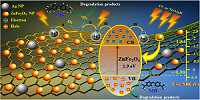
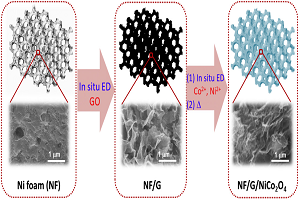

In this study, graphene (natural or synthesized), graphene oxide, reduced graphene oxide, highly reduced graphene oxide have been tested for improving performances as a super capacitor, sensor, and photocatalyst. Other methods have also been used such as doping of graphene with nitrogen or sulfur, using metal sulfides instead of metal oxides, and using highly porous materials as substrates. In the synthesis of these materials, a cleaner technology has been employed.
Keynote Forum
Bingqing Wei
University of Delaware, USA
Keynote: Stretchable Energy Storage Systems Enabled by Engineering Nano structured Carbon
Time : 9:25 - 09:50

Biography:
Dr. Bingqing (B. Q) Wei is currently a Full Professor in the Department of Mechanical Engineering at the University of Delaware. He was an Assistant Professor in the Department of Electrical & Computer Engineering and Center for Computation & Technology at Louisiana State University from 2003 to 2007. He had worked as a research scientist at Rensselaer Polytechnic Institute, Department of Materials Science and Engineering and Rensselaer Nanotechnology Center from 2000 to 2003. Dr. Wei was a visiting scientist for Max-Planck Institut für Metallforschung, Stuttgart, Germany in 1998 and 1999. From 1992 to 2001, he was a faculty member at Tsinghua University in Beijing, where he received his Bachelor’s degree (1987), M.S (1989), and Ph.D. (1992) in Mechanical Engineering. He is a member of The Materials Research Society (MRS), The Electrochemical Society (ECS), The American Chemical Society (ACS), and The American Society of Mechanical Engineering (ASME)
Abstract:
Keynote Forum
Gilbert Daniel Nessim
Bar Ilan University, Israel
Keynote: Towards the growth of 3D forests of carbon nanotubes: selective height control using reservoirs and overlayers
Time : 09:50 - 10:15

Biography:
The laboratory of Dr. Gilbert Daniel Nessim at Bar Ilan University (Israel) focuses on the synthesis of nanostructures using state-of-the-art chemical vapor deposition equipment. The scientific focus is to better understand the complex growth mechanisms of these nanostructures, to possibly functionalize them to tune their properties, and to integrate them into innovative devices.
Dr. Nessim joined the faculty of chemistry at Bar Ilan University in 2010 as lecturer and was promoted senior lecturer with tenure in 2014.
He holds a Ph.D in Materials Science and Engineering from the Massachusetts Institute of Technology (MIT), an MBA from INSEAD (France), and Masters in Electrical Engineering from the Politecnico di Milano and from the Ecole Centrale Paris (ECP, within the Erasmus/TIME program). Prior to his Ph.D, Dr. Nessim spent a decade in the high-tech industry and consulting across Europe, USA, and Israel.
Abstract:
Despite the massive progress achieved in the growth of carbon nanotube (CNT) forests on substrate, besides lithographic patterning of the catalyst, little has been done to selectively (locally) control CNT height. Varying process parameters, gases, catalysts, or underlayer materials uniformly affects CNT height over the whole substrate surface.1-2We will show here how we can locally control CNT height, from no CNTs to up to 4X the nominal CNT height from iron catalyst on alumina underlayer by patterning reservoirs or by using overlayers during annealing or growth.
We pioneered the concept of reservoir showing how an iron thin film reservoir placed below the alumina underlayer almost doubles CNT height3 and how a copper/silver thin film reservoir deactivates the iron catalyst placed above it.4 We will also show how different thin film reservoir materials can enhance CNT growth by a factor of 4X.
We also pioneered the concept of overlayer, where a copper stencil or bridge placed above the catalyst surface during pre-annealing or during CNT growth deactivates the catalyst.5 We showed how we could pattern regions with CNTs and without CNTs by simply annealing the sample with a patterned overlayer positioned above its surface. Using nickel overlayers, we obtained a similar result but with a completely different mechanism. We thus synthesized patterned CNT forests using a simple process, without the need for lithography.
We can now combine the overlayer technique with one of the above-mentioned reservoirs (no reservoir, Cu/Ag reservoir, or Fe reservoir) to further modulate CNT growth by offsetting some or all of the growth enhancements achieved using the reservoirs. This modulation of the CNT height is a significant improvement compared to the "CNTs (one height) / no CNTs" patterning that has been achieved using lithography of the catalyst, and moves us closer to building 3D architectures of CNTs.
Keynote Forum
Anirudha V Sumant
Center for Nano scale Materials, Argonne national laboratory, USA
Keynote: Towards developing energy efficient systems based on novel carbon materials
Time : 10:15 - 10:40

Biography:
Anirudha Sumant is a Materials Scientist working at Center for Nanoscale Materials, Argonne National leading the research on nanocarbon materials including CVD-diamond, carbon nanotube and graphene. He has more than 22 years of research experience in the synthesis, characterization and developing applications of carbon based materials. His main research interests include electronic, mechanical and tribological properties of carbon based materials, surface chemistry, micro/ nano-scale tribology, and micro-nanofabrication. He is the author and co-author of more than 100 peer reviewed journal publications, 2 book chapters, winner of four R&D 100 awards, NASA Tech Brief Magazine Award, 2016 TechConnect National Innovation Award, has 16 patents granted, and 15 pending and given numerous invited talks. His research in diamond materials helped in the formation of several start-up companies including NCD Technologies Inc. and AKHAN Semiconductors Inc. He is a member of MRS, STLE and AVS
Abstract:
Minimizing friction and wear-related mechanical failures remains as one of the greatest challenges in today’s moving mechanical systems leading to a search for new materials that can reduce friction and wear related energy losses and the understanding of fundamental mechanisms that control friction. In this context, our work on graphene has shown that this materials properties can be manipulated at the atomic level to achieve exceptionally high wear resistance, as well as well as achievement of superlubricity (or near zero friction) at macroscale through combined use of graphene and nanodiamonds on sliding surfaces [1]. This discovery presents a paradigm shift in understanding frictional behavior of graphene and other 2D materials and offers a direct pathway for designing energy efficient frictionless tribological systems. In the second part of my talk, I’ll describe our recent work on direct growth of wafer-scale graphene on diamond. The fact that the one atom thick graphene membrane strongly affected by the substrate interactions puts limit on exploiting excellent intrinsic properties of graphene for various applications. Diamond offers multiple unique properties, such as high phonon energy, low trap density, and high thermal conductivity, which make it an ideal substrate for fabricating graphene devices on diamond [2]. We demonstrate a novel process to grow large area single and few layer graphene directly on the diamond thin film deposited on silicon wafer thus eliminating the need for graphene transfer [3]. This approach offers new opportunities for developing graphene based nanoelectronic devices directly on dielectric substrate (diamond/Si) and provides reliable, efficient and low cost alternative as compare to current methods.
Coffee Break: 10:45 -11:05 @ Foyer
- Applications of graphene in energy | Carbon materials in energy | Semiconducor materials
Location: Zurich
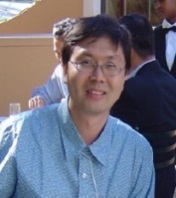
Chair
Jong-Sung Yu
Daegu Gyeongbuk Institute of Science and Technology, Republic of Korea

Co-Chair
Rajib Paul
Case Western University, USA
Session Introduction
Jong-Sung Yu
Daegu Gyeongbuk Institute of Science and Technology, Republic of Korea
Title: Elastic nano-graphene-functionalized silicon anode for lithium ion battery with superior cycle stability and rate capability
Time : 11:05 - 11:25

Biography:
Jong-Sung Yu earned his BSc in Chemistry from Sogang University in Seoul, Korea and a PhD from the University of Houston in 1990 before Post-doctoral work at Ohio State University. He was a Professor in Korea University during 2008-2015 before he moved to DGIST. Currently, he is a Supervisor for graduate students of Light, Salts and Water Research Lab and a Chair Person at Energy Systems Engineering Department of DGIST, where his research focuses on nanostructured materials, including nanoscale 0-3D materials and their composites, and their energy applications for fuel cells, batteries, super-capacitors, sensors, and photocatalytic systems.
Abstract:
Silicon (Si), one of the most promising anode materials for next generation high-performance Li-ion batteries (LIB), is popularly studied recently because of its super high lithium capacity (4200 mAh g-1). However, Si has a dramatic volume change (~300%) during charge-discharge cycling, leading to severe capacity decay and poor cycle stability originating from its structural collapse. Carbon or graphene-modified Si is an effective method to improve its performance. Traditional three models of carbon or graphene/Si-based core-shell, yolk-shell and physical wrapping have been reported recently. However, they are still insufficient in structure to solve the silicon issues. In our work, a new concept multifunctional nano-graphene shell is elaborately designed for silicon by a low-temperature chemical vapor deposition (CVD) method on a hierarchical nickel nano-template. The as-synthesized nano-graphene-functionalized silicon (Si@NG) composite shows unique functions to challenge the current silicon anode issues in LIB. The new functional nano-graphene shell gives the full consideration of Si issues such as Si conductivity, Si volume expansion, and mass transfer, which not only can supplement poor conductivity of Si, but also self-adaptively changes their space to accommodate the lithiated Si with inflated volume by their elastic feature. More importantly, different with traditional large graphene flakes, the graphene sheets in nano size has less ions barrier effect to guarantee easy Li+ and electrolyte paths.

In addition, the graphene layer provides excellent protection for SEI film to guarantee high cycle stability. As an anode electrode for LIB, the Si@NG composite exhibits excellent cycling performance with high reversible specific capacity (2330 mAh g−1 at 250 mA g-1 with an initial CE of 83.4%, and 1385 mAh g−1 at 500 mA g−1 after 510 cycles with a CE of 99.2%). A superior 95% capacity retention is achieved after 510 cycles. More notably, remarkable cycling performances were obtained over harsh testing conditions of high current density and high Si@NG loading, where the Si@NG still shows several times higher capacities than commercial graphite after 1000 cycles. All the electrochemical performances get benefits from the well-designed functional graphene shells. This work demonstrates a new direction towards the development of high efficient Si anode with high capacity and super cycle stability.
Yan Song
Institute of Coal Chemistry, China
Title: Porous worm-like NiMoO4 coaxially decorated electrospun carbon nanofibers as binder-free high performance electrodes for supercapacitors and lithium-ion batteries
Time : 11:25 - 11:45

Biography:
Song Y has her expertise in preparation and application of porous carbon and energy storage materials. She is Project Leader of the National 863 project, the National Natural Science Foundation of China, key research plan of Shanxi Province, etc. She made a breakthrough in the development of preparation of high performance carbon/silicon composite anode, the pore structure control of porous nano-carbon fibers. She got several awards, such as Lu Jiaxi Young Talent Award of CAS in 2009, second prize for Science Award in Shanxi Province in 2013, first prize for National Defense Science and Technology Innovation award in Shanxi Province in 2014 and so on.
Abstract:
Recently, various nanoscale NiMoO4 structures have been synthesized and evaluated as electrode materials in both SCs and LIBs due to the relatively low cost, abundant availability, environmental benignity and inherent electrochemical advantages. Given the NiMoO4 prepared in these works exhibits small surface area and dense structure, which impedes the fast ions transport and makes it difficult to alleviate the volume change. Therefore, it will be of great significance to grow porous NiMoO4 nanostructure directly on flexible substrates for effective energy storage. As another carbon textile, electrospun carbon nano fibers (ECNFs) exhibit smaller diameter and lighter mass when compared with conventional carbon cloth, which is favorable to increase the loading of NiMoO4, shorten ion/electron transport pathways and improve the utilization of NiMoO4. The peculiar architectures consisting of electrospun carbon nanofibers coaxially decorated by porous worm-like NiMoO4 were successfully fabricated for the first time to address the poor cycling stability and inferior rate capability of state-of-the-art NiMoO4-based electrodes. The porous worm-like structure endows the electrode high capacitance/capacity due to large specific surface area and short electron/ion diffusion channels. Moreover, the robust integrated electrodes with sufficient internal spaces can self- accommodate volume variance during charge/discharge processes, which is beneficial to the structural stability and integrity. By the virtue of rational design of the architecture, the hybrid electrode delivered high specific capacitance (1088.5 F g-1 at 1 A g-1), good rate capability (860.3 F g-1 at 20 A g-1) and long lifespan (73.9% capacitance retention after 5000 cycles at 10 A g-1) when applied as supercapacitor electrode. For lithium-ion battery application, the electrode exhibited a high reversible capacity of 689.7 mAh g-1 even after 150 continuous cycles at a current density of 1 A g-1.
Shengzhong Frank Liu
Shaanxi Normal University, China
Title: Graphene-oxide doped PEDOT: PSS as a superior whole transport material for high-efficiency perovskite solar cell
Time : 11:45 - 12:05

Biography:
Shengzhong Frank Liu is currently a Professor at Shaanxi Normal University and Dalian Institute of Chemical Physics, Chinese Academy of Science. After receiving his PhD in 1992, from Northwestern University (USA), he worked in US for about 20 years in companies including United Solar, BP Solar and Argonne National Laboratory. He recently accepted Professorship in China and started to build up his research labs in Xi’an and Dalian. His research interests include nanoscale materials, thin film materials, solar energy materials, electrochemical deposition, and development of photovoltaic technologies.
Abstract:
Organometal perovskite has turned into a promising candidate material for next generation solar cells due to its high power conversion efficiency and low-cost processing. Herein we report a superior whole transport material (HTM) for significantly improved solar cell efficiency. Upon doing the commonly used PEDOT:PSS HTM by graphene oxide (GO), its hole mobility is increased from 5.55×10-5 to 1.57×10-4 cm2V-1s-1, leading to efficient hole extraction and low current leakage, therefore 20% higher power conversion efficiency comparing to the control device without the GO doping. The development open the opportunities for efficient HTMs based on the two-dimensional materials in the perovskite solar cells.
Guohua Sun
Institute of Coal Chemistry, China
Title: Porous full carbon film of graphene and activated carbon fiber for flexible supercapacitors
Time : 12:05 - 12:25

Biography:
Guohua Sun has his expertise in preparation of porous carbon materials and graphene, and application in storage components. He has developed high-performance activated carbon and graphene in a large scale, which exhibits excellent electrochemical performance for supercapacitors.
Abstract:
Binder-free and free-standing flexible carbon film with a high specific surface and bimodal porous structure was successfully prepared by a facile vacuum-assisted filtration and subsequent annealing process, in which two-dimensional graphene oxide and one-dimensional activated carbon fibres were employed as the basic building blocks.

When the mass ratio of activated carbon fiber to graphene oxide was up to 2, the as-prepared flexible film exhibited a high energy density of 20 Wh kg-1 at a power density of 11.3 kW kg-1, with a good rate capability of 63.6% retention from 1 A g-1 to 8 A g-1 and excellent capacitance retention of 94.8% after 2000 cycles in a flexible supercapacitor with 1.0 M Et4NBF4/PC as the electrolyte.
Johann Bouclé
University of Limoges, France
Title: Graphene/TiO2 composites synthesized in one-step by laser pyrolysis for improved charge extraction in perovskite solar cells
Time : 12:25 - 12:45

Biography:
Johann Bouclé is currently working as an Associate Professor at the XLIM Research Institute, University of Limoges, France, where he manages a research axis devoted to hybrid optoelectronic devices based on organic and inorganic semiconductors. After a PhD in Physics obtained in 2004, he was appointed as Post-doctoral Research Associate at Imperial College London with Prof. Jenny Nelson and then at the University of Cambridge with Prof. Neil Greenham, to develop novel hybrid solar cells based on polymers and metal oxide nanostructures. He is currently involved in the scientific boards of various French bodies in the field of printed electronics and solar cells. He is Member of the International Advisory Board of the African Graphene Center, and currently contributes to the development of graphene-based materials for photovoltaic applications, and mainly perovskite solar cells.
Abstract:
Graphene materials, including pristine graphene, graphene oxide and reduced graphene oxide, are largely explored for their outstanding electronic and optical properties, making them relevant component of optoelectronic devices such as solar cells. In this context, various solar technologies have incorporated graphene-based component (active layer, transparent or non-transparent electrodes, charge extraction layers, etc.), leading in many cases to improved power conversion efficiencies with regard to traditional materials. These developments have been rapidly transposed to highly efficient perovskite devices, which are now considered as a realistic alternative to thin film technologies, considering their easy processing from solution and the relatively high performance achieved over the last few years. In this work, we propose an original approach for the development of graphene oxide/TiO2 composites, synthesized in a single-step by laser pyrolysis, to be used as electron-extracting layer in perovskite solar cells. This method, which was successfully employed in the field of solid-state dye-sensitized solar cell incorporating TiO2/carbon nanotube composites, is based on the direct integration of a graphene suspension in the precursor mixture used for the production of anatase TiO2 particle, using an infrared laser and an aerosol precursor mixture in a cross-flow and wall-less reactor.
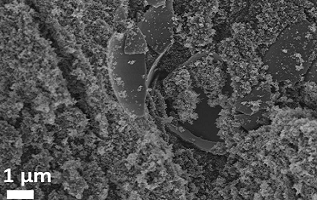
In this work, we will present the physical properties of TiO2/graphene composites by focusing on the electronic interactions between the TiO2 particles and graphene sheets using photoluminescence spectroscopy and Raman diffusion. We will also discuss the possibility to improve the charge transfer processes between the two components through the initial degree of reduction of the graphene used and the experimental conditions. Finally, we will evaluate the potentialities of the composites to demonstrate efficient selective contacts for perovskite solar cells.
Lunch Break: 12:50 - 13:30 @ Athens
Ruchi Gakhar
University of Wisconsin, USA
Title: Characterization of graphite components of FHR design
Time : 13:30 - 13:50

Biography:
Ruchi Gakhar is a Post-doctoral Research Associate at UW Madison in the Department of Nuclear Engineering and Engineering Physics. She received her PhD in Materials Science from University of Nevada, Reno in December 2015. She also holds an undergraduate and Master's degree in Chemistry and an additional Master's in Nanotechnology. During her PhD, she worked on designing of new, affordable materials to harness solar energy for clean energy production. She has published 15 journal articles and a book chapter so far. She has received several awards for academic excellence, including 2016 Nevada Regents' Scholar Award. At UW Madison, she is involved in investigating materials aspects of advanced nuclear reactor design–fluoride salt cooled high temperature reactor (FHR).
Abstract:
Two types of graphite used in the core design of Fluoride Salt Cooled High Temperature Reactor (FHR) are Graphite Matrix A3 and Nuclear Grade IG110. Matrix A3 forms the structural component for the fuel kernels, while IG110 forms the reflector blocks and some of the internal core components. Graphite forms an integral component of this design because it contributes to the structural integrity of the reactor as well as the pores of the graphite are considered as the main trapping site for the tritium produced in the coolant salt. Matrix A3 graphite which forms fuel pebble contains fission product that are produced during nuclear operation. In addition, the salt coolant or the corrosion products might intrude through the surface into the pores of the graphite. Considering these attributes, the microstructure characterization of two grades of graphite is important in developing knowledge of characteristics of graphite under FHR operating conditions. The microstructural differences between A-3 and IG-110 are attributed to the differences in the raw materials and the heat treatment temperature during manufacturing.

The present study focuses on the microstructure examination of two types of graphite components using X-ray Diffraction, Raman Spectroscopy, BET analysis, Mercury porosimetry and Scanning Electron Microscopy techniques. The lattice parameters, crystallite size (parallel and perpendicular to the basal plane), anisotropy and degree of graphitization estimated based on X-ray diffraction patterns and Raman spectra for both IG-110 and Matrix A3 graphite will be discussed. The similarities and differences in microstructural characteristics between the two grades of graphite as obtained using the XRD and Raman spectroscopy results will be presented and the factors causing such differences will be discussed.
Rajib Paul
Case Western Reserve University, USA
Title: Hierarchical 3D materials with vertically aligned carbon nano-structures for efficient energy applications
Time : 13:50 - 14:10

Biography:
Rajib Paul has extensive expertise in carbon material synthesis, fabrication and rational designing for efficient energy storage and conversion applications. He has developed a facile microwave radiation assisted functionalization technique for carbon based 3D porous structures. He is pioneered in nano-structuring of carbon surface through various plasma induced and thermal CVD methods. His additional research interest is related to thermal and mechanical properties evaluation in 3D hierarchical carbon structures. The foundation is based on understanding the junctional interfaces in 3D hierarchical carbon materials which play crucial roles in dictating transport and catalytic properties. He has demonstrated that the surface morphology, surface active states, and availability of carbon lattice edges evaluate the overall properties in 3D carbon structures.
Abstract:
Carbon based structural materials are attractive for energy application owing to their fascinating thermal and electrical conductivities, excellent mechanical properties and efficient catalytic activities. The sp2 hybridization in graphitic carbon lattice is responsible for such properties. The defect-free graphitic carbon structure is crucial for superior transport and mechanical properties whereas the structural or heteroatom induced defective states are desirable for efficient catalytic activities. However, the catalytic activities in defect-rich carbon materials are not always straightforward and depend on various factors, such as, type of defect, its density, surface morphology, porosity, surface area and activeness of surface defects. Furthermore, in case of hierarchically porous and three-dimensional (3D) carbon materials with abundant junctions between sp2 and sp3-hybridized carbon lattices, the understanding of catalytic and other physical properties is more difficult but important for advancement of energy storage technologies in 3 dimensions. We have opted different experimental techniques to fabricate different hierarchical carbon materials. We have grown vertically aligned few-layer graphene and carbon nanotubes (CNTs) to increase the intrinsic surface area of 3D structures. Moreover, we established an innovative technique to effectively functionalize those structures to provide active surface defects through heteroatoms (N, B) doping, for enhanced sorption based thermal energy recycling and electrochemical energy storage applications.

The active carbon surface demonstrated about 6-fold increase in methanol sorption enthalpy. We fabricated CNT, graphene and CNT-graphene hybrid-foams with ultra-low density (~4mg/cc) which showed ~200 % increased Li-ion storage capacity as binder-free anode. Vertically oriented CNTs grown on carbon-textiles and proper functionalization indicated high areal-capacitance of 107 mF/cm2 with excellent flexibility. We conducted experiments to understand and correlate the thermal transport and catalytic properties with structural details. The porosity is not always a dictating factor for thermal transport in 3D carbon structures rather the crystallinity and junctional properties determine the transport properties.
Ping Tang
Sichuan University, China
Title: Study on AlSb thin films prepared by pulsed laser deposition
Time : 14:10 - 14:30

Biography:
Ping Tang has her expertise in preparation and characterization of compound semiconductors and photovoltaic devices. Her research interest focuses on the study of novel compound semiconductors and related solar cells. At present, she is working on the fabrication of AlSb thin films and AlSb/ZnS based solar cells. She has succeeded in preparing AlSb thin film materials and fabricating AlSb based solar cells with architecture of TCO/ZnS/AlSb/Au and an open-circuit voltage of over 30 mV has been achieved.
Abstract:
AlSb is a kind of potential absorber material for thin film solar cells. In this paper, AlSb thin films were prepared by using pulsed laser deposition method, and the effects of substrate temperature on the properties of AlSb thin films were studied. XRD results showed that the average grain size of AlSb films increased with the increase of substrate temperature. AFM images suggested that the surface morphology of crystal AlSb thin films was continuous, homogeneous with high compactness. The electrical measurements showed that the AlSb films were semiconductors with the conductivity activation energy of 0.08, 0.17 and 0.01 eV. At the optimized temperature of 380ºc, the optical band gap of AlSb thin film was 1.52 eV. The obvious photovoltaic effect has been observed in TCO/ZnS/AlSb/Au device, which demonstrated that AlSb is a potential absorber for thin film solar cells. In present work, high quality AlSb thin films were prepared by using PLD method and the AlSb thin films we prepared were used in solar cells. The effects of substrate temperature on the properties of AlSb thin films were studied. High substrate temperature is helpful for the grain growth of AlSb films. The crystal growth was enhanced and the average grain size became larger with the increase of substrate temperature. The surface morphology of crystal AlSb thin films is continuous, homogeneous with high compactness. The electrical measurement exhibits that AlSb thin films prepared by PLD method are semiconductors with conductivity activation energy of 0.08, 0.17 and 0.01eV. The optical band gap of AlSb thin film is 1.52 eV at the optimized substrate temperature of 380ºc. Over 30 mV open circuit voltage is obtained in the TCO/ZnS/AlSb/Au device.
K Karthika
Seethalakshmi Ramaswami College, India
Title: Sonication assisted synthesis and characterization of organic and inorganic acid doped polyaniline materials
Time : 14:30 - 14:45

Biography:
K Karthika has completed her M Phil, PhD in Physics and is a UGC project fellow. Currently she is working in synthesis of conducting polymers, TiO2 and graphene based materials for energy conversion applications under the guidance of Dr. E Jasmine Vasantha Rani. She has done a project in Dye Sensitized Solar Cells by extracting natural dyes. She has published 6 papers and presented several papers in various national and international conferences.
Abstract:
In the current scenario, the conducting polymers are extensively studied due to their fascinating electronic properties and potential applications. In the present work, organic and inorganic acid doped polyaniline (PANI) salts and their dispersions were synthesized by chemical oxidative polymerization method assisted with sonication. Material characterization such as UV–Visible, FT–IR and FT–Raman were used to interpret their molecular structure, interacting nature and the effect of doping. The emission pattern of the samples was recorded through photoluminescence (PL) studies suggesting elongation of life time of charge carriers. The formation of nano fibers and nano rods were confirmed by TEM analysis. The dispersions were used as an electrolyte to measure the electrical conductivity. The electrical conductivity of the samples was found to be high due to better electron transport.
Daramola Abiodun Olamide
Walter Sisulu University, South Africa
Title: Facile synthesis of L-cysteine CdTe core shell system and its antioxidant properties
Time : 14:45 - 15:00

Biography:
Daramola Abiodun Olamide is a Material Scientist and specializes in the synthesis of nano-materials known as quantum dots. His passion is in the applicability of these materials in drug delivery system which helps in addressing some current epidemic diseases such as tuberculosis and cancer killing people every day. This has been achieved through the discovery of suitable method together with the unique optical and photo-physical properties produced by the materials. This process can successfully lead to the production of a simple drug model which can be used in our modern day society and recommended for large scale industrial purposes.
Abstract:
L-cysteine CdTe core and CdTe/CdSe core-shell were successfully synthesized in an aqueous solution medium. The synthesized QDs were analyzed using UV-vis absorption spectroscopy and florescence spectroscopy, transmission electron microscope (TEM), Fourier transform infra-red spectra (FT-IR) and X-ray powder diffraction (XRD). Systematic investigations were carried out for the determination of optimal condition namely: Reaction times, pH and mole ratios. Compared to CdTe core (529 nm), the core shell (601 nm) demonstrates a drastic shift in wavelength to the red region proving that as extra material had been deposited unto the surface of the core. The 20, 40 and 60 days stability tests conducted proved that core-shell nanoparticles were quite stable compared to the core material. Investigation was also conducted on the total anti-oxidant capacity (TAC) and lipid peroxidation with the use of six (8) Swiss albino mice and this was done using ferric reducing antioxidant power (FRAP) and TBARS was used to malondialdehyde (MDA) concentration.

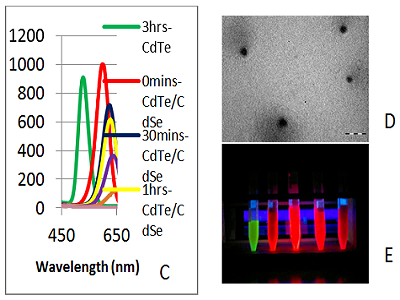
It was discovered that the core-shell demonstrated a poor anti-oxidant property at the heart, spleen, kidney and brain except at the liver where good anti-oxidant property was demonstrated after 24 and 72 hours of exposure. The result at the testis was not significant as against the control. Since this reaction did not involve the use of a nitrogen atmosphere nor special ligand or buffer solutions, it suggests that the process could be easily operated on an industrial scale.
Omotayo A Arotiba
University of Johannesburg, South Africa
Title: The application of Diamond, Graphene and Exfoliated graphite in electrochemical sensing and electrochemical degradation of organic pollutants in water

Biography:
Omotayo A. Arotiba is an Electrochemist with expertise in the applications of nanomaterials such as carbons, dendrimers, metal/metal oxides for the development of (bio)sensors and photo-electrochemical systems for biomedical, environmental (water) related problems. He is currently involved in the development of electrochemical water treatment technologies as well as sensors for toxic metals, toxins and many substances of biomedical importance. He received his BSc (Hons) and MSc in Industrial Chemistry from the University of Ilorin and the University of Benin both in Nigeria. He obtained his PhD (in 2009) from the Department of Chemistry, University of the Western Cape, South Africa. He joined the Department of Applied Chemistry, University of Johannesburg in 2010 where he is currently a Professor. He is a member of the International Society of Electrochemistry, Royal Society of Chemistry and South African Chemical institute
Abstract:
This work presents an overview of our research on the use of carbon – diamond, graphene and exfoliated graphite – in the development of electrochemical sensors and photoanodic electrodes for the electrochemical degradation of organic water pollutants. In electrochemical sensing, a novel ternary composite electrode from diamond, graphene and polyaniline was prepared, characterised and applied for the electrochemical determination of 2,4-dichlorophenol (2,4-DCP) in aqueous media. The composite, obtained via the oxidative polymerisation of aniline in the presence of graphene and diamond, was characterised by FTIR spectroscopy, Raman spectroscopy etc and used to modify a glassy carbon electrode. The electrochemical properties of the bare and modified electrodes were investigated using cyclic voltammetry, square wave voltammetry (SWV) and impedance. The determination of 2,4-DCP in 0.1 M HNO3 was carried out using SWV and a detection limit of 0.25 μM was calculated. The electrode exhibited antifouling capabilities during the electro-oxidation of 2,4-DCP. For electrochemical degradation, composites electrode consisting of exfoliated graphite (EG) and diamond were prepared and used for the electrochemical degradation of organics in water. The extent of degradation of the organics was monitored with UV/VIS spectroscopy and total organic carbon. Results showed that the incorporation of diamond into EG yielded a more robust electrode in terms of current density and also enhanced the rate of degradation of the organics. This approach is promising for the development of alternative or complementary methods for water treatment.
Marc Cretin
Université de Montpellier, France
Title: Carbon based materials: a promising approach for water depollution by electrochemical advanced oxidation processes

Biography:
Marc Cretin was born in France, in 1969. He received his Ph.D. degree in Electrochemistry (National Polytechnic Institute of Grenoble France) in 1996 and joined Geneva University to develop electrochemical sensors for biomedical and environmental analysis. In 1998 he gained a position of assistant professor (ENSCM/Montpellier/France) to work on membranes materials for detection, separation and reaction. He’s full professor since 2012 at the University of Montpellier and works mainly in the field of materials for energy and environment. He focuses his research mainly on electroactive materials for fuel cells, biofuel cells, EAOP (electrochemical advanced oxidation processes) and ceramic membranes for water treatment. He’s currently Director of the department “Physico-Chemistry, Interface and Polymer” at the European Membrane Institute of Montpellier (IEM) and co-director of the International French-Russia Laboratory MEIPA “Ion Exchange Membranes and Associated Processes”. Up to March 2017, he has co-authored more than 80 peer reviewed papers.
Abstract:
Gustavo Lopez Velazquez
Universidad de Guadalajara, Mexico
Title: Cuantum computation in a solid state diamond C12 with a chain of C13 atoms

Biography:
Abstract:
Somnath Bhattacharya
University of the Witwatersrand, South Africa
Title: Quantum device prospects of superconducting diamond films

Biography:
Somnath Bhattacharyya is a Professor in the School of Physics at the University of the Witwatersrand, Johannesburg, South Africa focusing on the area of condensed matter physics and nano-electronics. His major interest is in the transport properties of carbon and major achievements include the demonstration of resonant tunnel devices based on amorphous carbon, gigahertz transport in carbon devices, n-type doping of nanocrystalline diamond and developing theoretical models for transport in disordered carbon. His team focuses on the fabrication of the nanoelectronic devices, studying novel electronic properties of nanocrystalline diamond films and carbon superlattice structures at high magnetic fields and high frequencies. His group is also involved in performing theoretical modeling of carbon quantum structures. He is engaged in developing a new infrastructure for a wider range of nanotechnology that will include quantum matter, carbon based microwave detectors and nano-bio-electronics.
Abstract:
Nanostructured semiconducting carbon system, described by as a superlattice-like structure demonstrated its potential in switching device applications based on the quantum tunneling through the insulating carbon layer [1-4]. This switching property can be enhanced further with the association of Josephson’s tunneling between two superconducting carbon (diamond) grains separated by a very thin layer of carbon which holds the structure of the film firmly [5]. The superconducting nanodiamond heterostructures form qubits which can lead to the development of quantum computers provided the effect of disorder present in these structure can be firmly understood. Presently we concentrate on electrical transport properties of heavily boron–doped nanocrystalline diamond films around the superconducting transition temperature measured as a function of magnetic fields and the applied bias current. We demonstrate signature of anomalous negative Hall resistance in these films close to the superconductor-insulator-normal phase transition at low bias currents at zero magnetic field [5]. Current vs. voltage characteristics show signature of Josephson-like behavior which can give rise to a characteristic frequency of several hundred of gigahertz. Signature of spin flipping also shows novel spintronic device applications. We are working towards utilizing the superconducting phenomena in nanodiamond films in making some novel quantum electronic and high speed devices. This project complements our previous work on nitrogen-doped nanodiamond films and related nanostructured carbon devices which showed interesting radio frequency features in the gigahertz range [6].
- Graphene modification and functionalization | Nano carbon materials | Applications of graphene in biomedical
Location: Zurich

Chair
Adam Khan
AKHAN Semiconductor, Inc., USA
Co-Chair
Yung Woo Park
Seoul National University, South Korea
Session Introduction
Guang Li
Donghua University, China
Title: The control of pore sizes in porous carbon fiber and its enhanced microwave absorption

Biography:
Dr. Guang Li received her M.Sc in Chemistry from China Textile University in 1985, and her Ph.D in material science and engineering from Donghua University in 2006. She was a Senior Visiting Scholar in the University of Twente (Netherlands). She has been a full Professor at Donghua University sine 1999, and continuously working on high performance polymer , porous carbon fibers and their associated processing and applications. She has published more than 100 scientific papers in high-impacting peer-reviewed journals and has given more than 24 keynote/invited/oral presentations, co-authored 4 books, and owns 26 patents. Dr. Li has been awarded several prizes for recognizing her contributions to science and technology.
Abstract:
As one of carbon materials, the porous carbon fiber has played a great role as catalyst support, separation by absorption, gas storage etc. based its high aspect ratio. Among related publications, few studies focused on the microwave absorption characteristics of porous carbon fibers, although a great number of papers concerned carbon materials such as carbon black, fiber, tube as microwave absorbents[1-3]. In this study, Porous carbon fibers were prepared through carbonization of the blend fibers composed of poly(acrylonitrile) (PAN) and poly(methyl methacrylate) (PMMA)with 70 wt % of PAN. The pore size in porous carbon fibers could be controlled by changing the average molecular weight of PAN, The pores of 1-10μm and 0.1-1μm in diameter were obtained from the blend fibers where the average molecular weight of PAN is 51000 and 83000 g/mol, respectively(Figure 1). The obtained porous carbon fibers were used as absorbents to make epoxy composites with addition of 2-6 wt %. The microwave absorption properties were stimulated based on a model for a single-layer plane wave absorber. The results explained the porous carbon fiber showed much better microwave absorption than carbon nanofiber, and the porous carbon fiber with small size of pores showed much better microwave absorption than that with large size of pores, as shown in figure 2. It is believed that the enhanced microwave absorption from the porous carbon fibers is due to a combination of the dielectric-type absorption and the interference of multi-reflected microwaves[3-6]. When the pore size in porous carbon fibers is large, the air-absorber interfaces could be reduced at the same pore volume. Therefore, the superior microwave absorption of composites filled by porous carbon fiber with smaller pore size may be ascribed to the combination of absorption and interference of microwaves.
Anirudha V Sumant
Center for Nanoscale Materials, Argonne, National Laboratory,USA
Title: Towards developing energy efficient systems based on novel carbon materials

Biography:
Anirudha Sumant is a Materials Scientist working at Center for Nanoscale Materials, Argonne National leading the research on nanocarbon materials including CVD-diamond, carbon nanotube and graphene. He has more than 22 years of research experience in the synthesis, characterization and developing applications of carbon based materials. His main research interests include electronic, mechanical and tribological properties of carbon based materials, surface chemistry, micro/ nano-scale tribology, and micro-nanofabrication. He is the author and co-author of more than 100 peer reviewed journal publications, 2 book chapters, winner of four R&D 100 awards, NASA Tech Brief Magazine Award, 2016 TechConnect National Innovation Award, has 16 patents granted, and 15 pending and given numerous invited talks. His research in diamond materials helped in the formation of several start-up companies including NCD Technologies Inc. and AKHAN Semiconductors Inc. He is a member of MRS, STLE and AVS.
Abstract:
Minimizing friction and wear-related mechanical failures remains as one of the greatest challenges in today’s moving mechanical systems leading to a search for new materials that can reduce friction and wear related energy losses and the understanding of fundamental mechanisms that control friction. In this context, our work on graphene has shown that this materials properties can be manipulated at the atomic level to achieve exceptionally high wear resistance, as well as well as achievement of superlubricity (or near zero friction) at macroscale through combined use of graphene and nanodiamonds on sliding surfaces [1]. This discovery presents a paradigm shift in understanding frictional behavior of graphene and other 2D materials and offers a direct pathway for designing energy efficient frictionless tribological systems. In the second part of my talk, I’ll describe our recent work on direct growth of wafer-scale graphene on diamond. The fact that the one atom thick graphene membrane strongly affected by the substrate interactions puts limit on exploiting excellent intrinsic properties of graphene for various applications. Diamond offers multiple unique properties, such as high phonon energy, low trap density, and high thermal conductivity, which make it an ideal substrate for fabricating graphene devices on diamond [2]. We demonstrate a novel process to grow large area single and few layer graphene directly on the diamond thin film deposited on silicon wafer thus eliminating the need for graphene transfer [3]. This approach offers new opportunities for developing graphene based nanoelectronic devices directly on dielectric substrate (diamond/Si) and provides reliable, efficient and low cost alternative as compare to current methods.
Yung Woo Park
Seoul National University, Korea
Title: Manipulation of electrical properties in CVD-grown twisted bilayer graphene induced by dissociative hydrogen adsorption
Time : 15:00 - 15:20

Biography:
Y W Park graduated summa cum laude in 1975 from the Physics Department of Seoul National University in South Korea. He received his PhD from University of Pennsylvania, Philadelphia, United States in 1980. His PhD thesis on the "Electrical Transport Studies of Pure and Doped Polyacetylene" was supervised by Professor Alan J Heeger. He was involved in the original discovery of conducting polymers in 1977 under the guidance of Prof. Alan J Heeger. He has made unique contributions on the synthesis and transport studies of carbon based nanostructures such as conducting polymer nanofibers, carbon nanotube, organic conductors, molecular conductors and graphene. He has also contributed significantly to the transport and mechanism studies of highly correlated materials, such as high Tc superconductors. In particular, his recent discovery of "Zero magneto resistance in polymer nanofibers" is his most important and seminal achievement. In particular, the CNT based nonvolatile MEMS memory has achieved a 1000 times faster switching speed, applicable to the MP3s, smart phones and cameras with very low power consumption and possible multinary bit devices
Abstract:
The effect of hydrogen adsorption on twisted bilayer graphene (tBLG) was studied. Raman spectroscopy and the electrical transport properties (electrical resistance and thermoelectric power) confirm that the electron doping by hydrogen adsorption, in agreement with the previous report involving exfoliated bilayer graphene (BLG). Common electron doping behavior were observed at various twist angles (0o, 5o, 12.5o and 30o), and the adsorptions follow the first–order Langmuir-type adsorption model. Specifically, we analyzed the off-state currents, with band-gap openings of around 13 meV in tBLG with twist angle of 0o, as in Bernal-stacked BLG.
Adam Khan
AKHAN Semiconductors, Inc., USA
Title: Thin film nanocrystalline diamond for optical and monolithically integrated display applications
Time : 15:20 - 15:40

Biography:
Adam Khan is the Founder and CEO of AKHAN Semiconductor. He is currently leading the technology development program. His research interests include theoretical work in unconventional superconductor systems and applied work in n-type diamond semiconductor systems. He is listed inventor to over 11 issued and pending patents and has authored several published technical works in addition to roles like co-chairing technical conferences and symposia. He is also the winner of a 2013 R&D 100 award, Clean Tech Open Midwest Innovation Summit winner, and 2014 Forbes 30, under 30 in Energy and Industry. He earned his BS in Electrical Engineering and Physics from the University of Illinois Chicago, before pursuing graduate research at Stanford University’s Stanford Nanofabrication Facility.
Abstract:
Diamond is well-known for its extreme hardness, high- optical transparency, high thermal conductivity, and great chemical stability. In spite of all these excellent properties, diamond has largely been absent in optical applications due to the difficulty in fabricating high quality diamond thin films at lower substrate temperatures cost efficiently. Pioneering work on low temperature, high quality diamond deposition methods by AKHAN semiconductor Inc. has opened doors for the use of diamond in a wide variety of optical applications. Nanocrystalline diamond (NCD) coatings with grain size of 10-100 nm can significantly enhance the breakage, scratch performance and hydrophobicity of glass displays and lenses. In this work, NCD thin films of 50-250 nm thickness were deposited on commercial BK7 glass and chemically hardened aluminosilicate glass (Gorilla Glass) substrates using hot filament and microwave plasma chemical vapor deposition (HFCVD and MWCVD) techniques under optimized substrate temperatures to avoid substrate deformation.
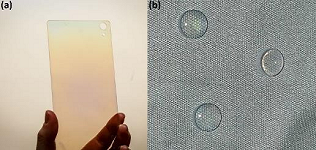
Optical characterization work of the as deposited NCD films was performed using ellipsometry, spectral reflectance and spectrophotometry over visible wavelengths. Mechanical characterization work was also performed to obtain hardness and young’s modulus data for the NCD films. Measured results demonstrate the viability of NCD as a protective coating for a broad range of optical applications. Additionally, low temperature, high quality diamond deposition allows complementary metal oxide semiconductor (CMOS) device integration on optical substrates opening new opportunities for the development of next-generation monolithically integrated transparent devices and electronics.
Zahra Sadeghian
Research Institute of Petroleum Industry, Iran
Title: Superhydrophilic functionalized graphene oxide-ceramic composite membrane for enhanced oily produced water treatment
Time : 15:40 - 16:00

Biography:
Zahra Sadeghian is Associate Professor of Materials Science and Engineering. She has received PhD from TU Clausal, Germany in 2005. She has done Post-doctoral Fellowship in Chemical Engineering (membrane process) at RWTH Aachen University in 2010. She is working at Research Institute of Petroleum Industry from 2005. Her expertise is in nanostructured coatings for surface modification and nanomaterial synthesis such as carbon nanotube and graphene and their composites. Also, she has been investigating on ceramic composites in adsorbent, biomaterials, catalysts and membranes applications. She has experiences in oilfield produced wastewater treatment and desalination pilot plant using ceramic membranes and their composites. She has been fabricating ceramic membranes for separation of hydrogen from syngas and other gases.
Abstract:
The largest wastewater stream is generated in oil and gas industries. In order to meet environmental regulations as well as reuse and recycling of produced water, treating oily produced water is very important. In this research, nanofiltration (NF) membranes with functionalized graphene oxide (F-GO) for wastewater treatment have been worked on. In this work, the synthesized GO from our previous work (Fig. 1a) was first functionalized with polyethyleneimine (PEI). The PEI–GO thin film has been constructed on home-made microporous γ-alumina/alumina substrate to enhance and improve the characteristics of nanofiltration (NF) alumina membranes. Fig. 1b shows microstructure of ceramic membrane surface modified PEI-functionalized GO representing compressed thin layers. The interactions between PEI–GO and the alumina matrix are caused to make passageways for water rapidly passing through membrane. Also the contact angle and zeta potential results showed a notable increase in surface hydrophilicity of the thin layers accompanying presence of positively charged PEI. The filtration properties of the membrane were tested by home-made cross flow NF using oily wastewater with oil concentration of feed 5000 mg/L. High oil (>99%) and total organic carbon (TOC) rejection (>99%) was obtained using the prepared membrane.

Also the water flux was almost 10 times higher than that of the pristine alumina membrane. The permeation flux-decline is decreased to an ultralow level (less than 1%) that it turns to the antifouling layers on modified membrane surface. The superior antifouling property is mainly focused on surface structure of the membrane such as superhydrophilic character and charge of the modified alumina surface. As a result, the PEI–GO/alumina hybrid membrane showed an effective method for preparing composite NF membranes with effective reinforced permeation and superior antifouling property that it improves the performance of the oil separation and wastewater treatment.
Coffee Break: 16:05 -16:25 @ Foyer
Pedro Alpium
International Iberian Nanotechnology Laboratory, Portugal
Title: Graphene functionalized field-effect transistors for biomedical applications
Time : 16:25 - 16:45

Biography:
P Alpuim is the Group Leader in 2D materials and devices at INL. He works in 2D materials CVD and device fabrication, with emphasis in biosensors. Optoelectronic devices for light detection and solar energy conversion are within his research interests. He is a Professor in the Physics Department of the University of Minho (UM), where he teaches graduate and undergraduate courses on the physics of electronic devices, nanotechnology, and clean-room fabrication. He received a PhD degree in Materials Engineering from IST Lisbon in 2003, working in silicon thin film devices for flexible electronics, and a Master’s degree in Physics from the UM in 1995. He installed a thin-film laboratory at UM where he focused on fabrication of thin-film silicon solar cells, piezo resistive sensor arrays for health care and thermoelectric junctions of telluride compounds for micro-cooling and energy scavenging.
Abstract:
The importance of bio sensing systems in biomedical research is steadily increasing, as they became pervasive in a large range of health applications, from prognosis and diagnosis to personalized medicine. Graphene is a material of choice for sensing applications, with its highly conjugated, high mobility, zero bandgap 2D electronic system providing extreme sensitivity to charges and electric fields in its vicinity, combined with a high chemical stability and ease of processing. However, specific target biorecognition on graphene requires surface functionalization. We developed a general process for immobilization of probe molecules on graphene surfaces, based on π-π interactions with a pyrenic linker (PBSE). Electrolyte-gated field-effect transistors (FETs), with receded integrated gate architecture were fabricated at the 200 mm wafer scale followed by functionalization of the graphene channel for detection of antigens and DNA.
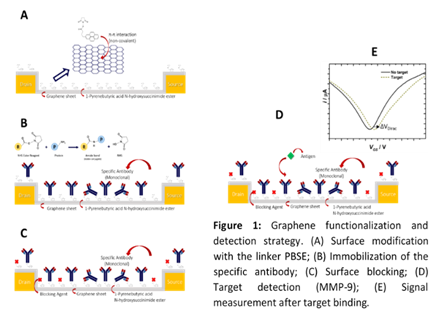
A graphene immuno-FET is designed to detect the biomarkers of the hemorrhagic transformation of ischemic stroke. The probe is immobilized by reaction of the PBSE succinimidyl ester groups with a primary amine from the antibody protein. The device is able to detect the biomarker (MMP-9) in concentrations down to 0.01 ng/mL, in a range up to 10 ng/mL. Compared with existing MMP-9 immunoassays, ours has a much shorter time to diagnostic since it is based on a simpler label-free protocol. The nucleic acid sensor is made by immobilization of single-stranded DNA (25 nucleotides long) on the PBSE-functionalized graphene transistor channel. Hybridization with complementary DNA was detected down to 1 aM, with a saturation attained at 100 fM and sensitivity to single nucleotide polymorphism. These results show that the fabrication of graphene sensors using standard clean-room technology, with high sensitivity and low cost, is possible.
Yanli Wang
Shanghai University, China
Title: Mass production of functionalized graphene quantum dots and their application in cancer diagnosis and therapy
Time : 16:45 - 17:05

Biography:
Yanli Wang is currently working at Institute of Nanochemistry and Nanobiology of Shanghai University as Associate Professor since 2012. She obtained her PhD degree in Environmental Engineering from Shanghai University in 2010. Her research interests mainly focus on bio-effects and safety evaluation of nanomaterials and their application in bio-imaging and cancer therapy.
Abstract:
Graphene quantum dots (GQDs) have garnered increasing attention because of their various alluring physicochemical properties and a wide range of potential application. However, their large-scale applications are limited by current synthetic methods that commonly produce GQDs in small amounts. Moreover, GQDs usually exhibit polycrystalline or highly defective structures and thus poor optical properties. We established a new mass-productive synthesis method of single-crystalline GQDs via a green and low-cost alkali-mediated hydrothermal molecular fusion using an active PAH molecule as a precursor. Functionalized GQDs featured excellent optical properties, strong excitonic absorption bands extending to the visible region, large molar extinction coefficients, and long-term photo-stability. Positively charged amino-GQDs could easily pass through cell membranes and localize in cell cytoplasm but show acute toxicity in vivo causing death of mice even after tail vein injection at low concentrations. Negatively charged sulfonic-GQDs could not pass through the cell membrane even after co-incubation for 48 hours under normal culture conditions. However, specific targeting of cell nuclei was found when cells were cultured in an ultrathin film with the sulfonic-GQDs.
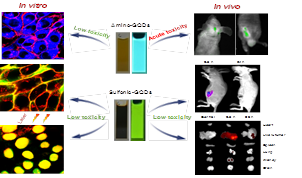
Both subcutaneous and orthotopic mice tumor models revealed thatthe sulfonic-GQDs showed specific targeting performance for the tumor tissues in vivo. Confocal images of frozen tumor and normal tissue sections further demonstrated the exceptional in vivo cancer-cell-nuclear-targeting capability of the sulfonic-GQDs, which showed no cancer type specificity. Both materials showed good performance for both in vitro and in vivo imaging, however, the toxicity issues of the amino-GQDs may limit their in vivo applications. Negatively charged sulfonic-GQDs showed low toxicity both in vitro and in vivo, which indicates their good potential for clinical applications.
Jinlong Liu
National Natural Science Foundation of China, China
Title: Luminescence characteristics and related damage evolution of carbon ion implanted GaN
Time : 17:05 - 17:20

Biography:
Jinlong Liu has his expertise in preparation and functional application of carbon materials including diamond, graphene, carbon dots and so on. He focuses on the mechanism of research on the carbon materials functional properties. He has researched the conductivity mechanism of H-terminated diamond and developed the MESFET devices. He also conducted research on luminescence mechanism of carbon dots prepared by micro wave heating and clarified the chemical reaction mechanism. In this work, he studied the defective evolution of carbon ion implanted GaN after annealing by slow positron annihilation, and the results will provide a framework to understand the behavior of carbon in GaN. It will be of great importance in expanding further application of C doped GaN.
Abstract:
Statement of the Problem: Carbon doped GaN has been widely studied and applied for p-type GaN and yellow light-emitting diodes. However, the sites carbon located, related with luminescence, characteristics has not been confirmed.
Methodology & Theoretical Orientation: GaN was implanted with carbon ion using dose of 1×1017 cm-2 and 2×1017 cm-2 and energy of 30 keV and 40 keV. And then the implanted samples were annealed at 800℃ for 20 min and 1 h under the N2 atmosphere. The luminescence characteristics of carbon ion implanted GaN was evaluated by PL spectrum with wavelength of 325 nm. The lattice damage of GaN was characterized by Raman spectrum and corresponding vacancy-defect evolution before and after annealing was measured by slow positron annihilation.

Conclusion & Significance: Most of carbon atoms would be located at the interstitial sites after carbon ion implantation due to the absorption of vacancies, and no obvious luminescence could be observed. As the implanted samples were annealed, strong yellow luminescence was emitted and the vacancy for N (VN) or vacancy for Ga (VGa) was reduced resulting from the migration of interstitial carbon (Ci) and formation of complex between them. By contrast, samples with higher dose showed stronger yellow light emission, which was related with the lower migration rate of Ci and saturated concentration of Ci-V complex.
Hussein Alrobei
University of South Florida, USA
Title: Aluminum -hematite nanocomposite films for photo electrochemical applications
Time : 17:20 - 17:35

Biography:
Hussein Alrobei is a PhD student under the supervision of Manoj K Ram. He has background in the field of Photo Electrochemical, Advanced Materials, Polymers and Energy. He has been involved on photo electrochemical properties on various metal oxides, polymers and conducting polymers, and recently his patent on nano-hybrid structured regioregular polyhexylthiophene blend films for production of photo electrochemical energy has been approved.
Abstract:
The alpha ( )–hematite (Fe2O3) based photoelectrochemical (PEC) devices are attractive due to splitting of water into hydrogen and oxygen, and it is has been studied extensively due to its bandgap, cost effectiveness, chemical stability and availability in nature. However, – Fe2O3 shows low carrier diffusion, higher resistivity, low electron mobility and higher photocorrosion. The mobility and carrier diffusion properties of –Fe2O3 can be improved by transition metal ion doping or making composite with metal oxide. So, attempt is made to make –Fe2O3 composite with aluminum (Al). Various ratios of Al with - Fe2O3 composite nanomaterials were synthesized using a sol-gel method. The Al- -Fe2O3 nanomaterial was characterized using SEM, FTIR and UV-vis techniques and X-ray diffraction, techniques. The cyclic voltammetric study was performed in three electrode cell where Al- - Fe2O3 worked as working electrode coated on conducting FTO glass plate, steel as counter and Ag/AgCl as reference electrode to estimate the diffusion coefficient and understanding of electrode/electrolyte interface. The Al doping has shown changes in the structural, optical, morphological and electrochemical properties of Al- -Fe2O3 compared to pristine - Fe2O3 photocatalyst. The photoelectrochemical properties of Al- - Fe2O3 based electrode has been understood through band diagrams. The photocurrent and band gap has clearly shown the improved hydrogen generation using Al- -Fe2O3 photocatalyst.
Dandan Xu
Beijing Forestry University, China
Title: Ionic liquid-stabilized graphene and its use in decorated with Co nano catalyst towards chlorinated organic pollutants degradation
Time : 17:35 - 17:50

Biography:
Dandan Xu is a Doctoral Candidate of Ecological Environment Engineering at Beijing Forestry University. She has been committed to environmental profession for 9 years. She has her expertise in electrochemical process to treat organic pollutants from the graduate studies. Her work on preparing electrocatalytic cathode based on ionic liquid creates new aspect for improving electrocatalytic performance. She has participated in several international conferences in many cities.
Abstract:
Tremendous efforts have been devoted to find methods with high-efficient and low-cost to remove chlorinated organic pollutant from aqueous solutions. Metal nanoparticles modified graphene materials have attracted considerable attention, but the limitation is the difficulty in depositing metal nanoparticles with uniform size and good dispersion on graphene surface. Ionic liquid (IL) shows potential for overcoming some of the above mentioned issues due to their high chemical and thermal stability, negligible vapor pressure, high conductivity and wide electrochemical window. This paper involved functionalization of graphene samples with IL ([Bmin][BF4]) and in situ reduction of cobalt precursors to improved their electrocatalytic performance and application on electrochemical degradation of chlorinated organic pollutants. Several characterization methods such as XRD, SEM and XPS were used to analyze prepared samples crystal structures, surface morphology, composition and nanoparticles size. XPS measurement showed the wide survey XPS pattern of catalyst, which indicated the coexistence of C, N, O and Co in the catalyst, and element N was originated from the IL. The sizes of Co nanoparticles on Co/IL-graphene (3.33 nm) was smaller than that on Co/graphene (6.60 nm) due to stabilization of IL.
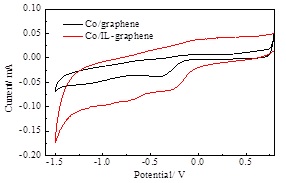
Electrocatalytic measurements revealed Co/IL-graphene catalysts displayed enhanced current response compared with Co/graphene samples. And a strong reduction peak at 0.036 V presented for Co/IL-graphene which was quite different from the Co/graphene catalyst. It indicated that the Co nanoparticles IL functionalized graphene had a significant electrocatalytic activity. The addition of IL can not only improve the dispersity of Co nanoparticle, but also increase the active sites. The Co/IL-graphene nanocomposite will be suitable materials for degradation of chlorinated organic pollutants in aqueous solutions.
